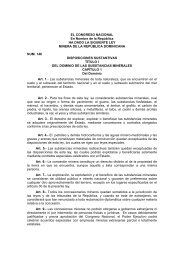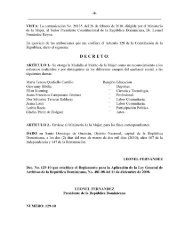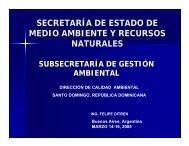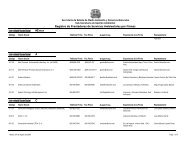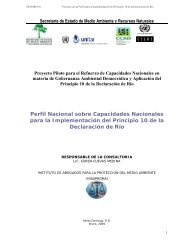CAMBIO CLIMATICO
CAMBIO CLIMATICO
CAMBIO CLIMATICO
You also want an ePaper? Increase the reach of your titles
YUMPU automatically turns print PDFs into web optimized ePapers that Google loves.
REPÚBLICA DOMINICANA 2003<br />
October of 1998 before the UN Framework<br />
Convention on Climate Change, assuming the<br />
commitments in accordance with Article 12 of<br />
this Convention.<br />
1.3 NATIONAL INVENTORY OF<br />
GREENHOUSE GAS<br />
EMISSIONS AND SINKS:<br />
1990-1994<br />
The first inventory in the Dominican Republic was<br />
made for the years 1990 and 1994, following the<br />
1996 Good Practice Guidance and the<br />
Intergovernmental Panel on Climate Change (IPCC).<br />
The reports of the inventory for these years address<br />
the estimation of the main direct greenhouse gases,<br />
such as carbon dioxide (CO 2 ), methane (CH4), and<br />
nitrous oxide (N2O), as well as the indirect greenhouse<br />
gases recommended in the Revised<br />
Guidelines (IPCC-OECD-IEA), such as carbon<br />
monoxide (CO), nitrogenous oxides (NOX), nonmethane<br />
volatile organic compounds (NMVOCs),<br />
and sulfur dioxide (SO2). Since the necessary information<br />
was not available for these inventory<br />
reports, the estimates of the emissions of the following<br />
direct greenhouse effect gases were not<br />
made: hydrofluorocarbons (HFCs), perfluorocarbons<br />
(PFCs), and sulfur hexaflouride (SF6).<br />
1.3.1 National Emissions, years 1990<br />
and 1994<br />
1.3.2 Gross emissions, 1990 and 1994<br />
The results for gross emissions obtained for<br />
these years are as follows:<br />
Carbon dioxide (CO 2 ) produced emissions of 8<br />
690.81 in 1990 and 15 003.05 in 1994. As noted,<br />
in these years the largest proportion of the emissions<br />
came from CO 2 , with 95.6% in 1990 and<br />
93.7% in 1994; the increases in emissions of CO 2<br />
and CO are associated with the increase in the burning<br />
of fuels for energy observed during this period.<br />
The rest of the gases constituted a smaller proportion<br />
of the emissions; for example, those of<br />
methane (CH4) were 144.74 for 1990 and 221.9<br />
for 1994; those of nitrous oxide (N2O) were 2.71<br />
for 1990 and 2.51 for 1994; those of nitrogenous<br />
oxides (NOX) were 54.11 for 1990 and 77.9 for<br />
1994; carbon monoxide (CO) was 351.04 for 1990<br />
and 510.23 for 1994. Of the non-methane volatile<br />
organic compounds (NMVOCs), emissions were<br />
65.22 and 75.46 for 1994, and for sulfur dioxide<br />
(SO2), 76.73 for 1990 and 116.74 for 1994.<br />
As noted, in these years the largest proportion of<br />
emissions came from CO 2 , with 95.6% in 1990<br />
and 93.7% in 1994; the increases in emissions of<br />
CO 2 and CO are associated with the increase in<br />
the burning of fuels for energy observed during<br />
this period. The rest of the gases constitute a<br />
smaller proportion of the emissions.<br />
1.3.3 Net Emissions<br />
The total gross greenhouse emissions/absorptions<br />
by gases and sectors for the years 1990<br />
and 1994 (sic). The largest proportion is represented<br />
by carbon dioxide (CO 2 ), 3049.59 for<br />
1990 and 8369.48 for 1994. As with gross emissions,<br />
CO 2 made up the largest proportion of<br />
these, with 80.4% for 1990 and 88.8% for 1994.<br />
Its relative weight in emissions increased during<br />
these years due to the increase noted in the<br />
burning of fossil fuels for energy. On the other<br />
hand, methane (CH 4 ) produced emissions of<br />
149.59 in 1990 and 227.45 in 1994. Nitrous<br />
oxide (N2O) produced emissions of 2.74 in 1990<br />
and 2.55 in 1994; nitrogenous oxides (NOX)<br />
55.31 in 1990 and 79.27 in 1994, carbon<br />
monoxide (CO) in 1990 produced 393.47 and in<br />
1994 558.82; the non-methane volatile organic<br />
compounds (NMVOCs) produced 65.22 and<br />
75.46 for 1994; sulfur dioxide (SO2) was 77.06<br />
for 1990 and 116.34 for 1994.<br />
1.3.4 Relative Contribution to Global<br />
Warming. Aggregate Emissions<br />
of CO 2 Equivalents (CO 2 -e)<br />
The different gases do not contribute to the same<br />
degree to the increase in the greenhouse effect. To<br />
express GEG emissions based on equivalents that<br />
42



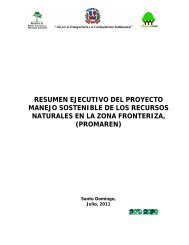
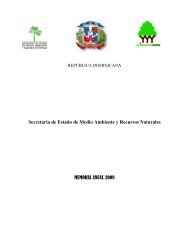

![Documento de trabajo del grupo G-77[1] EconomÃa verde en el ...](https://img.yumpu.com/50859069/1/190x245/documento-de-trabajo-del-grupo-g-771-economa-a-verde-en-el-.jpg?quality=85)




